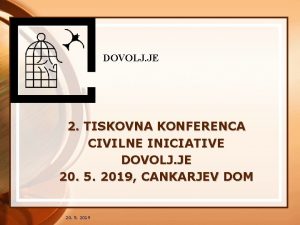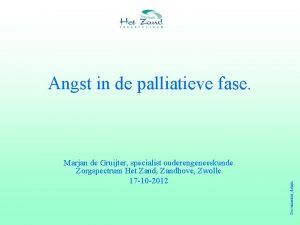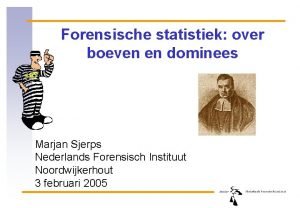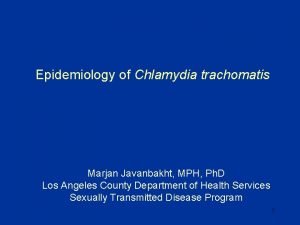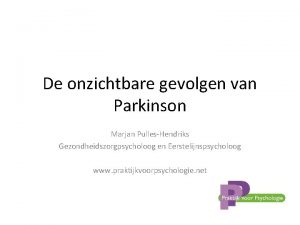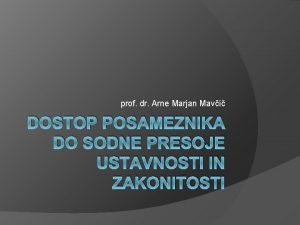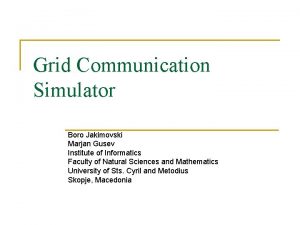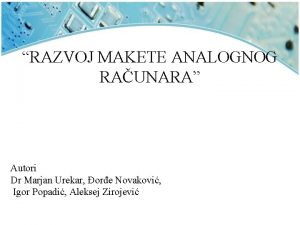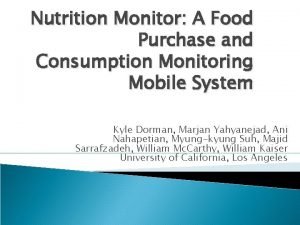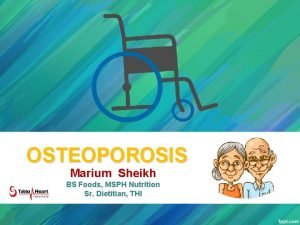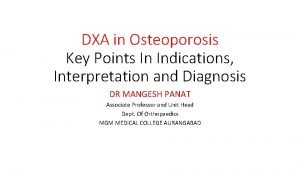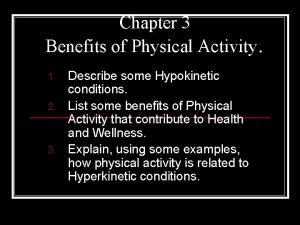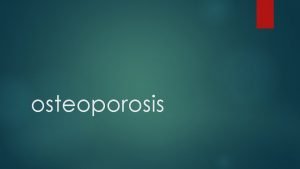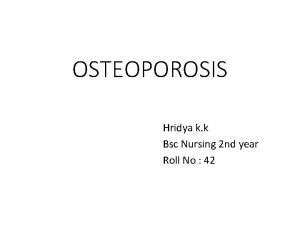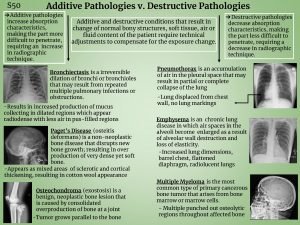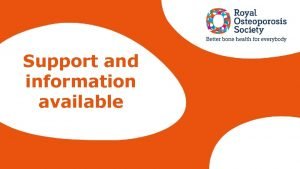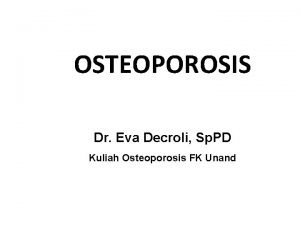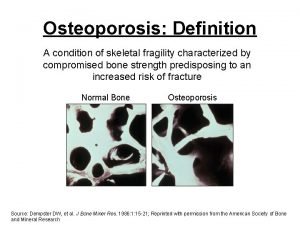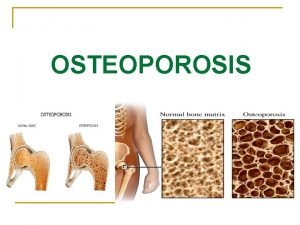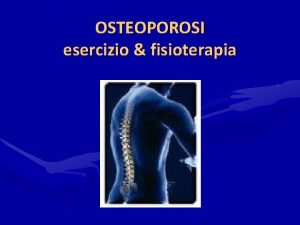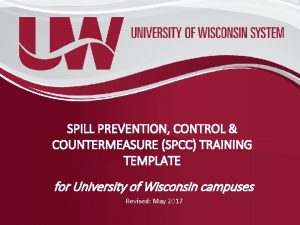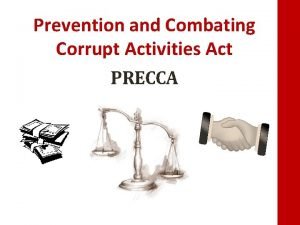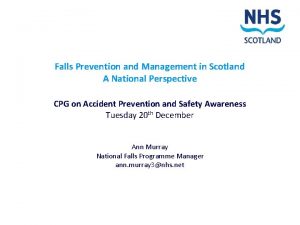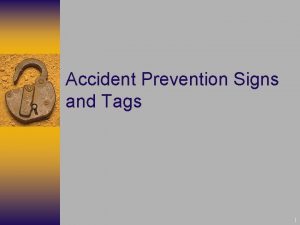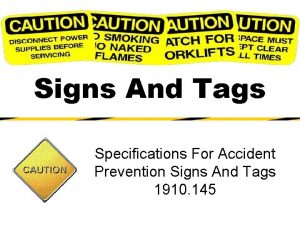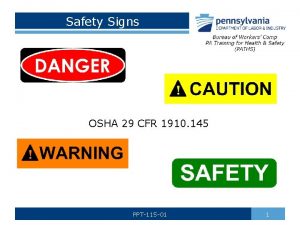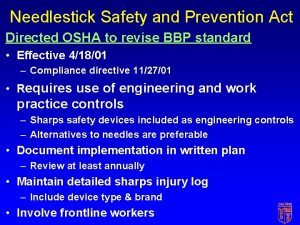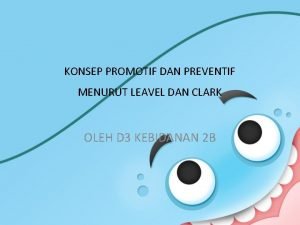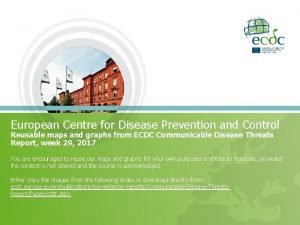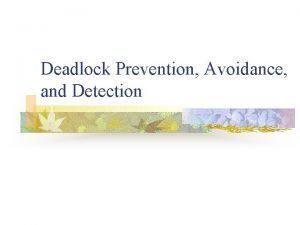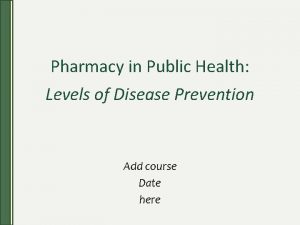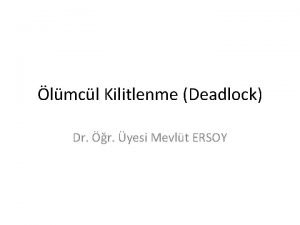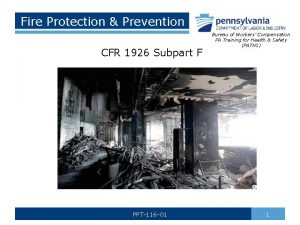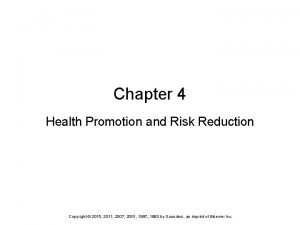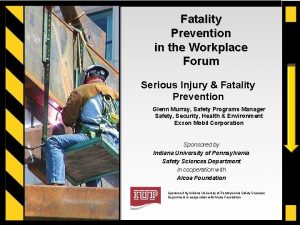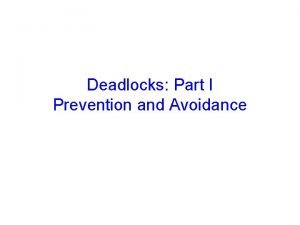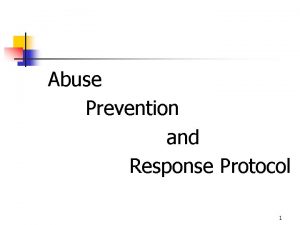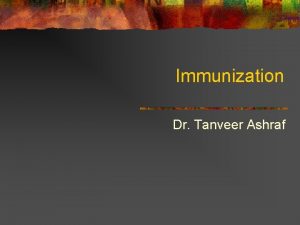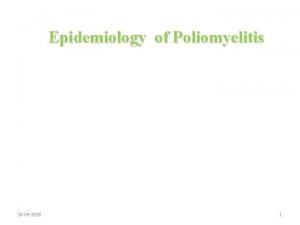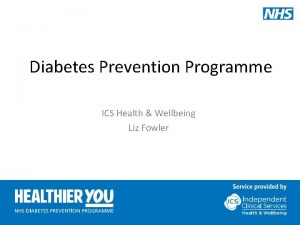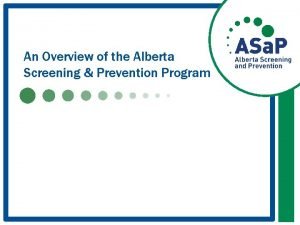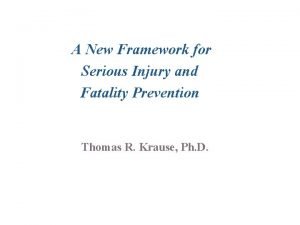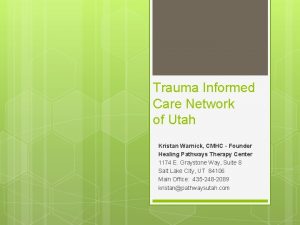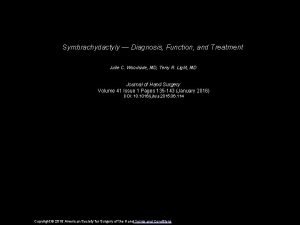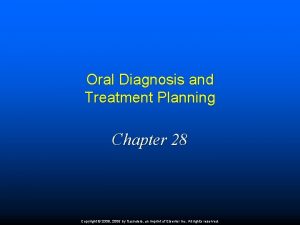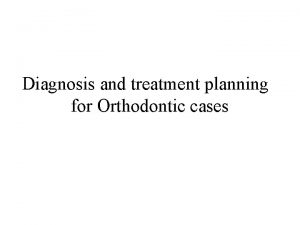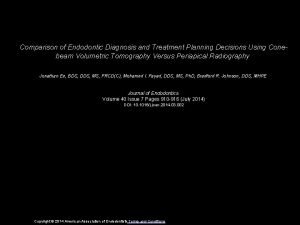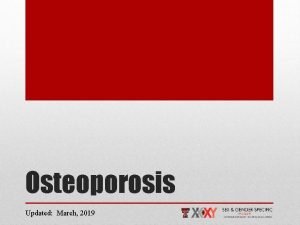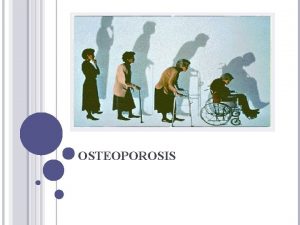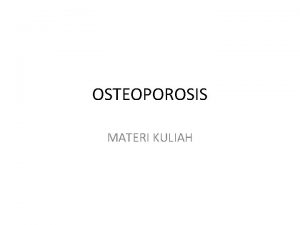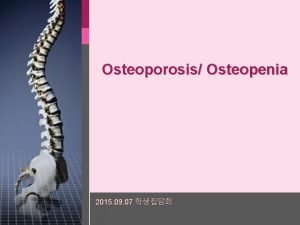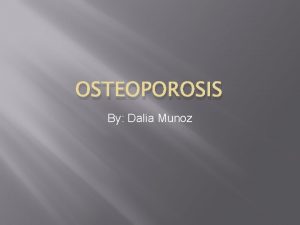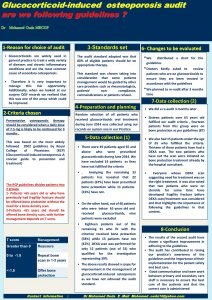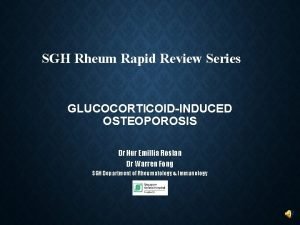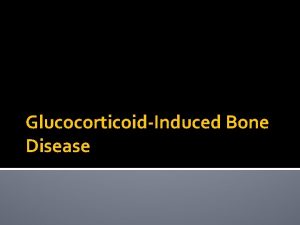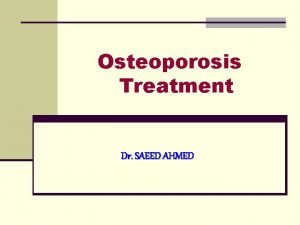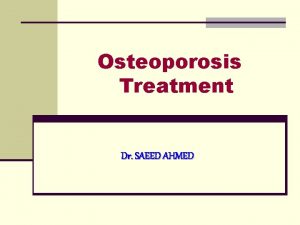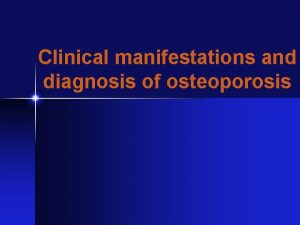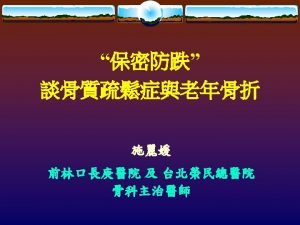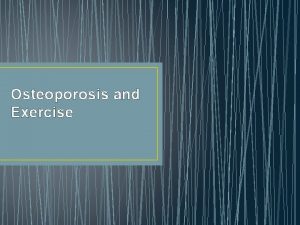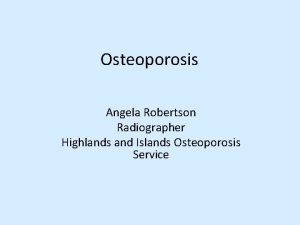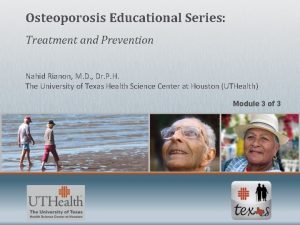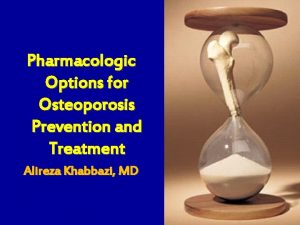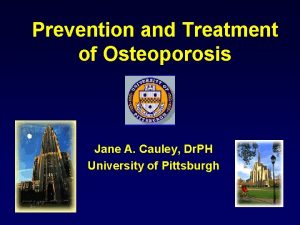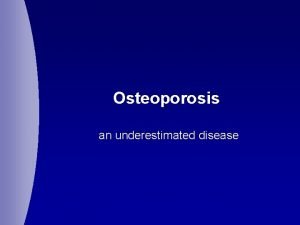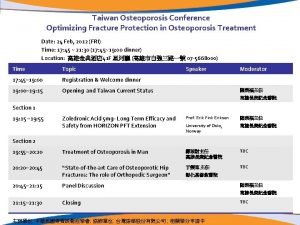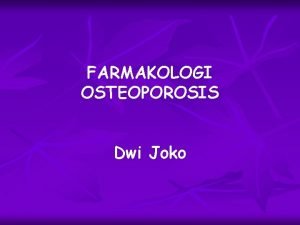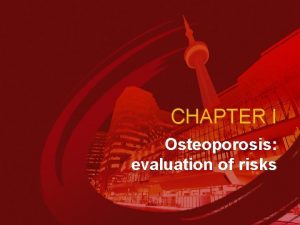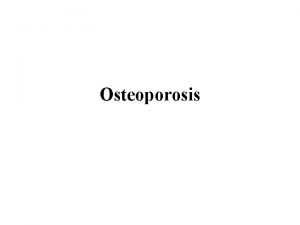PREVENTION AND TREATMENT OF GLUCOCORTICOIDINDUCED OSTEOPOROSIS Dr Marjan

















![[at >3 units/day] or smoking) and other clinical comorbidities, and a physical examination including [at >3 units/day] or smoking) and other clinical comorbidities, and a physical examination including](https://slidetodoc.com/presentation_image_h/91a699b8b5425984c30e1743594b9e32/image-18.jpg)

















































- Slides: 67

PREVENTION AND TREATMENT OF GLUCOCORTICOIDINDUCED OSTEOPOROSIS Dr. Marjan Khayamzadeh

AGENDA GIO pathogenesise fracture risk assessment fracture risk reassessment Treatment Follow up




GC treatment is a potentially reversible risk factor for glucocorticoid-induced osteoporosis if GC treatment is terminated, BMD increases and fracture risk declines. In addition, the absolute risk of future fracture in an individual is substantially influenced by demographic and other characteristics

(age, race, sex, and concomitant OP risk factors). For these reasons, it is important to identify those patients taking GCs for whom the benefits of preventive therapy sufficiently outweigh potential harms.


Recommendations

A strong recommendation means that the Panel was confident that the desirable effects of following the recommendation outweigh the undesirable effects(or vice versa), so the course of action would apply to all or almost all patients, and only a small proportion would not want to follow the recommendation.

A conditional recommendation means that the Panel believed the desirable effects of following the recommendation probably outweigh the undesirable effects, so the course of action would apply to the majority of the patients, but some may not want to follow the recommendation.

A good practice recommendation means that although the Panel believed the benefits of proceeding according to the guidance far outweigh the harms, the supporting evidence is indirect, and the Panel did not formally assess the relevant evidence.

More than 10% of patients who receive longterm GC treatment are diagnosed with a fracture. 30– 40% have radiographic evidence of vertebral fractures.

Recommendations for fracture risk assessment and reassessment

All of the fracture risk assessment and reassessment recommendations are made as good practice recommendations.

In all adults and children, an initial clinical fracture risk assessment should be performed as soon as possible, but at least within 6 months of the initiation of long-term GC treatment.

This assessment should include a history with the details of GC use (dose, duration, pattern of use), an evaluation for falls, fractures, frailty, and other risk factors for fracture (malnutrition, significant weight loss or low body weight, hypogonadism, secondary hyperparathyroidism, thyroid disease, family history of hip fracture, history of alcohol use
![at 3 unitsday or smoking and other clinical comorbidities and a physical examination including [at >3 units/day] or smoking) and other clinical comorbidities, and a physical examination including](https://slidetodoc.com/presentation_image_h/91a699b8b5425984c30e1743594b9e32/image-18.jpg)
[at >3 units/day] or smoking) and other clinical comorbidities, and a physical examination including measurement of weight and height (without shoes), testing of muscle strength, and assessment for other clinical findings of undiagnosed fracture (i. e. , spinal tenderness, deformity, and reduced space between lower ribs and upper pelvis) as appropriate given the patient’s age.

In addition, for adults >40 years of age, the initial absolute fracture risk should be estimated using FRAX with the adjustment for GC dose and BMD testing (if available, or without BMD if it is not available) as soon as possible, but at least within 6 months of the initiation of GC treatment.

For adults <40 years of age, BMD testing should be done as soon as possible but at least within 6 months of the initiation of GC treatment if the patient is at high fracture risk because of a history of previous OP fracture(s) or if the patient has other significant OP risk factors (malnutrition, significant weight loss

or low body weight, hypogonadism, secondary hyperparathyroidism, thyroid disease, family history of hip fracture, smoking, alcohol use at >3 units/day).



Increase the risk generated with FRAX by 1. 15 for major osteoporotic fracture and 1. 2 for hip fracture if glucocorticoid (GC) treatment is >7. 5 mg/day (e. g. , if hip fracture risk is 2. 0%, increase to 2. 4%). Major osteoporotic fracture includes fractures of the spine (clinical), hip, wrist, or humerus.

Reassessment of fracture risk: In all adults and children who continue GC treatment, a clinical fracture risk reassessment should be performed every 12 months

For adults >40 years of age who continue GC treatment and are not treated with an OP medication beyond calcium and vitamin D, reassessment with FRAX, with BMD testing if available, should be completed every 1– 3 years. This reassessment should be performed earlier within this 1– 3 -year time range for adults age >40 years who are receiving very high doses of GCs.

(initial prednisone dose >30 mg/day, cumulative dose >5 gm in the previous year) or those with a history of OP fracture(s). Later or less frequent testing within this range can be done for adults age >40 years who are taking lower doses of GCs with no other OP risk factors.

For adults >40 years old who continue GC treatment and are currently treated with an OP medication in addition to calcium and vitamin D, BMD testing should be completed every 2– 3 years during treatment in highrisk patients such as those receiving very high-dose GCs(initial prednisolone dose>=30 mg/dl,

cumulative dose 5 gm in the previous year), a history of OP fracture occurring after >18 months of treatment with antifracture medication (other than calcium and vitamin D), risks for poor medication adherence or absorption, or other significant OP risk factors.

For adults >40 years old who received an OP treatment in the past but are no longer being treated with an OP medication other than calcium and vitamin D, BMD testing should be done every 2– 3 years.

Within this range, reassessment should be conducted earlier in patients receiving higher doses of GCs and those with a history of fracture or low BMD, and later in those receiving lower doses of GCs, with higher BMD and no other OP risk factors.

Adults <40 years of age. For all adults <40 years of age who continue GC treatment and are at moderate-to-high fracture risk (history of previous fracture, BMD Z score < -3, received very high-dose prednisone [>=30 mg/day and cumulative dose >5 gm] in

the previous year, risks for poor medication adherence or absorption, or multiple OP risk factors), BMD testing should be done every 2– 3 years.


Recommendations for treatment

Calcium and vitamin D intake and lifestyle modifications: Optimizing calcium intake (1, 000– 1, 200 mg/day) and vitamin D intake (600– 800 IU/day; serum level >=20 ng/ml)

lifestyle modifications (a balanced diet, maintaining weight in the recommended range, smoking cessation, regular weightbearing or resistance training exercise, limiting alcohol intake to 1– 2 alcoholic beverages/day) (conditionally recommended for all patients receiving GC treatment)

Initial pharmacologic treatment. Adults >=40 years of age. Women>=40 years of age and not of childbearing potential and men >=40 years of age who are at moderateto-high risk of fracture should be treated with an oral bisphonate (strong recommendation for those at high risk; conditional recommendation for those at moderate risk).

For patients in whom oral bisphonates are not appropriate (for example, due to comorbidities, patient preference, or concerns about adherence with an oral medication regimen), IV bisphonates should be used rather than the patient receiving no additional treatment beyond calcium and vitamin D.

If bisphonate treatment is not appropriate, teriparatide should be used rather than the patient receiving no additional treatment beyond calcium and vitamin D. If neither oral nor IV bisphonates nor teriparatide treatment is appropriate, denosumab should be used.

For postmenopausal women in whom none of these medications is appropriate, raloxifene should be used rather than the patient receiving no additional treatment beyond calcium and vitamin D. The order of the preferred treatments was determined based on a comparison of efficacy (fracture reduction), toxicity, and cost. ( These are conditional recommendations)

For adults <40 years of age (women not of childbearing potential and men) with a history of OP fracture, or those continuing GC treatment (>=6 months at a dose of >=7. 5 mg/day) who have either a hip or spine BMD Z score<-3 or bone loss of>=10%/year at the hip or spine as assessed by DXA, an oral bisphonate

be used rather than the patient receiving no additional treatment beyond calcium and vitamin D. If treatment with an oral bisphonate is not appropriate, the same alternative medications listed for adults >=40 years of age are recommended with the exception of raloxifene, which is not used in men and premenopausal women. (These are conditional recommendations)

Special populations: For women who meet criteria for moderate-tohigh risk of fracture and are of childbearing potential , but do not plan to become pregnant within the period of OP treatment and are using effective birth control or are not sexually active, an oral bisphonate should

be used rather than the patient receiving no additional treatment beyond calcium and vitamin D. If oral bisphonate treatment is not appropriate, teriparatide should be used rather than the patient receiving no additional treatment beyond calcium and vitamin D.

Because of the lack of safety data and the potential fetal harm associated with denosumab in animal studies and with highdose IV bisphonates , these therapies should be used only in women who are at high risk of fracture in whom treatment with an oral bisphonate and teriparatide

is not appropriate. Denosumab or IV bisphonate treatment should be initiated only after a discussion with the patient about the very low quality of evidence about fetal harms in the event of an unplanned pregnancy. (These are conditional recommendations)

There is a lack of data on the safety of currently available OP treatments during pregnancy. Therefore, these guidelines do not include recommendations about OP prevention or treatment, other than calcium and vitamin D intake and lifestyle modification, in women who are pregnant.

For adults 30 years of age who are receiving very high-dose GC treatment (initial prednisone dose of >=30 mg/day [or equivalent GC exposure] and a cumulative annual dose of >5 gm) , oral bisphonate treatment should be initiated. If treatment with an oral bisphonate is not appropriate, the agerelated recommendations for second-line therapy should be followed (These are conditional recommendations)

For adults who have received an organ transplant and who are continuing treatment with GCs , the age-related treatment recommendations outlined in these guidelines for men and women who do not have transplants should be followed if the glomerular filtration rate is >=30 ml/minute and there is no evidence of metabolic bone disease.

An evaluation by an expert in metabolic bone disease is recommended before initiating pharmacologic treatment in adults with a renal transplant. The Panel made a recommendation against the use of denosumab because of lack of safety data in this population of patients who are treated with multiple immunosuppressive agents. (These are conditional recommendations)

For GC-treated children 4– 17 years of age, a calcium intake of 1, 000 mg/day and vitamin D intake of 600 IU/day is recommended. For children who have had an OP fracture who continue GC treatment at a dose of >=0. 1 mg/kg/day for >=3 months, treatment with an oral bisphonate (or an IV bisphonate if oral treatment is not appropriate) is recommended. (These are conditional recommendations)


Follow-up treatment recommendations

Initial treatment failure Treatment if moderate-to-high fracture risk persists after bisphonate therapy Treatment if GCs are discontinued

Initial treatment failure Adults age >=40 years continuing GC treatment who have had a fracture that occurred after >=18 months of treatment with an oral bisphonate or who have had a significant loss of bone mineral density (>=10%/year):

Treat with another class of OP medication (teriparatide or denosumab; or, consider IV bisphonate if treatment failure is judged to be due to poor absorption or poor medication adherence) recommended rather than the patient receiving no additional treatment beyond calcium and vitamin D alone or continuing oral bisphonate treatment. (conditional recommendation)

Treatment if moderate-to-high fracture risk persists after bisphonate therapy For adults >=40 years of age who have completed 5 years of oral bisphonate treatment who are continuing GC treatment and are assessed to be at moderate-to-high risk of fracture, continuation of active OP treatment (in addition to calcium and vitamin D) is recommended rather than the patient receiving no additional treatment beyond calcium and vitamin D.

Suggested treatment options include continuing the oral bisphonate for 7– 10 years, switching to an IV bisphonate if absorption or adherence is a problem, or treatment with another class of OP medication (teriparatide or denosumab), depending on the response to the initial

Bisphonate treatment (change in BMD, new fractures) and with consideration of rare risks, including jaw necrosis and atypical femur fractures, which might increase with the duration of antiresorptive therapy. (conditional recommendations)

Treatment if GCs are discontinued Adults age >=40 years taking an OP medication in addition to calcium and vitamin D who discontinue GC treatment and are assessed to be at low risk of fracture: Discontinue the OP medication but continue calcium and vitamin D over continuing the OP medication. (Conditional recommendation)

Adults age >=40 years taking an OP medication in addition to calcium and vitamin D who discontinue GC treatment and are assessed to be at moderate-to-high risk of fracture: Complete the treatment with the OP medication over discontinuing the OP medication. (strong recommendation for high risk and conditional recommendation for moderate risk)

Alendronate 48 week , randomized, placebo-controlled study, two doses of alendronate 477 men and women, 17 to 83 years of age Primary end point: change in lumbar BMD Result: the mean lumbar BMD increased by 2. 1+/- 0. 3 % and 2. 9+/- 0. 3 %. in 5 and 10 mg per day of alendronate and decreased by 0. 4+/ -0. 3% in placebo group.

Risedronate 12 months double-blind placebo controlled study 290 men and women Primary end point: lumbar BMD Result: increased BMD by a mean of 2. 9% at lumbar spine, BMD was maintained only in the control group

Risedronate &Zolendronate 12 months double blind study, 5 mg IV zolendronic acid versus 5 mg oral residronate 833 men and women randomised 1: 1 Primary end point: lumbar BMD Result: zolendronic acid was non inferior and superior to residronate for increase of lumbar BMD in treatment and prevention

Teriparatide & Alendronate 18 month randomized double-blind controlled trial 428 women and men , 22 to 89 years Primary out come: lumbar BMD Result: increased BMD in teriparatide 7. 2+/0. 7% more than alendronate group 3. 4+/-0. 7%

Teriparatide & Risedronate 18 months randomized open labled trial , 20 micg/d teriparatide versus 35 mg/week risedronate 92 men, mean age 56. 3 y, Tscore <-1. 5 Primary out come: lumbar BMD Results: increased trabecular BMD significantly greater with teriparatide 16. 3% versus 3. 8%
 Primary prevention secondary prevention tertiary prevention
Primary prevention secondary prevention tertiary prevention Pashal prša
Pashal prša Marjan de gruijter
Marjan de gruijter Marjan sjerps
Marjan sjerps Marjan javanbakht
Marjan javanbakht Marjan pulles
Marjan pulles Chairba
Chairba Arne marjan mavčič
Arne marjan mavčič Marjan gusev
Marjan gusev Password marjan
Password marjan Dr marjan novakovic
Dr marjan novakovic Marjan yahyanejad
Marjan yahyanejad Marjan gusev
Marjan gusev Pes statement for osteoporosis
Pes statement for osteoporosis T score osteoporosis
T score osteoporosis Is osteoporosis hypokinetic or hyperkinetic
Is osteoporosis hypokinetic or hyperkinetic Loss defination
Loss defination Nursing diagnosis of osteoporosis
Nursing diagnosis of osteoporosis Woc osteoporosis
Woc osteoporosis Additive and subtractive pathology in all body system
Additive and subtractive pathology in all body system Royal osteoporosis society leaflets
Royal osteoporosis society leaflets Osteoporosis
Osteoporosis Eva decroli
Eva decroli Bone fragility meaning
Bone fragility meaning God bone
God bone Osteoporosis definition
Osteoporosis definition International osteoporosis foundation
International osteoporosis foundation Osteoporosis
Osteoporosis Spill prevention control and countermeasure plan template
Spill prevention control and countermeasure plan template Prevention and combating of corrupt activities act summary
Prevention and combating of corrupt activities act summary Colorado jprs
Colorado jprs Injury prevention safety and first aid
Injury prevention safety and first aid Falls prevention scotland
Falls prevention scotland Puncture resistant container
Puncture resistant container Chapter 26 infectious disease prevention and control
Chapter 26 infectious disease prevention and control Chapter 19 disease transmission and infection prevention
Chapter 19 disease transmission and infection prevention Accident prevention tags may be used
Accident prevention tags may be used Accident prevention signs and symbols
Accident prevention signs and symbols Sign with white background with a green panel
Sign with white background with a green panel Osha needlestick protocol
Osha needlestick protocol Tingkat pelayanan kesehatan menurut leavel dan clark
Tingkat pelayanan kesehatan menurut leavel dan clark European centre for disease prevention and control
European centre for disease prevention and control Deadlock prevention or avoidance
Deadlock prevention or avoidance Health promotion and levels of disease prevention
Health promotion and levels of disease prevention Policy on harassment prevention and resolution
Policy on harassment prevention and resolution Starvation deadlock
Starvation deadlock What is the subpart for fire protection and prevention
What is the subpart for fire protection and prevention Chapter 19 disease transmission and infection prevention
Chapter 19 disease transmission and infection prevention Health promotion and levels of disease prevention
Health promotion and levels of disease prevention Professional nursing practice concepts and perspectives
Professional nursing practice concepts and perspectives School crisis prevention and intervention
School crisis prevention and intervention 1910 subpart l
1910 subpart l Serious injury and fatality prevention
Serious injury and fatality prevention Deadlock prevention vs avoidance
Deadlock prevention vs avoidance Chapter 16 infection prevention and control
Chapter 16 infection prevention and control Abuse prevention and response protocol
Abuse prevention and response protocol Loss prevention and security in hotels
Loss prevention and security in hotels Prevention and control of poliomyelitis
Prevention and control of poliomyelitis Poliomyelitis slideshare
Poliomyelitis slideshare Ics health & wellbeing
Ics health & wellbeing Alberta screening and prevention program
Alberta screening and prevention program Serious injury and fatality prevention
Serious injury and fatality prevention Trauma awareness and treatment center utah
Trauma awareness and treatment center utah Symbrachydactyly treatment before and after
Symbrachydactyly treatment before and after Chapter 28 oral diagnosis and treatment planning
Chapter 28 oral diagnosis and treatment planning Class iii
Class iii Lip length in complete denture
Lip length in complete denture Endodontic diagnosis and treatment planning
Endodontic diagnosis and treatment planning

